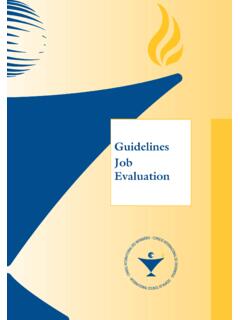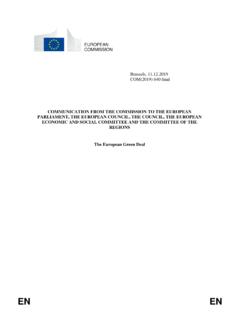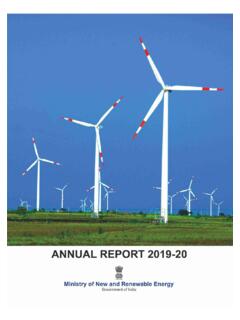Transcription of guidelines vertical en - European Commission
1 EN EN EN EN EN European Commission Brussels, SEC(2010) 411 Commission NOTICE guidelines on vertical Restraints {C(2010) 2365} {SEC(2010) 413} {SEC(2010) 414} EN 2 EN Commission NOTICE guidelines on vertical Restraints (Text with EEA relevance) TABLE OF CONTENTS Paragraphs Page I. INTRODUCTION 1-7 4 1. Purpose of the guidelines 1-4 4 2. Applicability of Article 101 to vertical agreements 5-7 5 II. vertical AGREEMENTS WHICH GENERALLY FALL OUTSIDE ARTICLE 101(1) 8-22 5 1.
2 Agreements of minor importance and SMEs 8-11 5 2. Agency agreements 12-21 6 3. Subcontracting agreements 22 9 III. APPLICATION OF THE BLOCK EXEMPTION REGULATION 23-73 9 1. Safe harbour created by the Block Exemption Regulation 23 9 2. Scope of the Block Exemption Regulation 24-46 10 3. Hardcore restrictions under the Block Exemption Regulation 47-59 17 4. Individual cases of hardcore sales restrictions that may fall outside Article 101(1) or may fulfil the conditions of article 101(3) 60-64 22 5. Excluded restrictions under the Block Exemption Regulation 65-69 23 6. Severability 70-71 25 7. Portfolio of products distributed through the same distribution system 72-73 25 IV. WITHDRAWAL OF THE BLOCK EXEMPTION AND DISAPPLICATION OF THE BLOCK EXEMPTION REGULATION 74-85 25 1.
3 Withdrawal procedure 74-78 25 2. Disapplication of the Block Exemption Regulation 79-85 26 EN 3 EN V. MARKET DEFINITION AND MARKET SHARE CALCULATION 86-95 28 1. Commission Notice on definition of the relevant market 86 28 2. The relevant market for calculating the 30 % market share threshold under the Block Exemption Regulation 87-92 28 3. Calculation of market shares under the Block Exemption Regulation 93-95 30 VI. ENFORCEMENT POLICY IN INDIVIDUAL CASES 96-229 30 1. The framework of analysis 96-127 30 Negative effects of vertical restraints 100-105 32 Positive effects of vertical restraints 106-109 33 Methodology of analysis 110-127 36 Relevant factors for the assessment under Article 101(1) 111-121 36 Relevant factors for the assessment under Article 101(3) 122-127 39 2.
4 Analysis of specific vertical restraints 128-229 40 Single branding 129-150 40 Exclusive distribution 151-167 45 Exclusive customer allocation 168-173 49 Selective distribution 174-188 51 Franchising 189-191 55 Exclusive supply 192-202 57 Upfront access payments 203-208 59 Category management agreements 209-213 60 Tying 214-222 61 Resale price restrictions 223-229 63 EN 4 EN I. INTRODUCTION 1. Purpose of the guidelines (1) These guidelines set out the principles for the assessment of vertical agreements under Article 101 of the Treaty on the Functioning of the European Union (hereinafter "the Treaty").
5 1 Article 1(1)(a) of Commission Regulation (EU) [insert new Regulation number] on the application of Article 101(3) of the Treaty on the Functioning of the European Union to categories of vertical agreements and concerted practices2 (hereinafter referred to as the "Block Exemption Regulation") (see paragraphs 24 to 46) defines the term " vertical agreement". These guidelines are without prejudice to the possible parallel application of Article 102 of the Treaty to vertical agreements. The guidelines are structured in the following way: Section II (paragraphs 8 to 22) describes vertical agreements which generally fall outside Article 101(1); Section III (paragraphs 23 to 73) clarifies the conditions for the application of the Block Exemption Regulation; Section IV (paragraphs 74 to 85) describes the principles concerning the withdrawal of the block exemption and the disapplication of the Block Exemption Regulation; Section V (paragraphs 86 to 95) gives guidance on how to define the relevant market and calculate the market shares; Section VI (paragraphs 96 to 229) describes the general framework of analysis and the enforcement policy of the Commission in individual cases concerning vertical agreements.
6 (2) Throughout these guidelines the analysis applies to both goods and services, although certain vertical restraints are mainly used in the distribution of goods. Similarly, vertical agreements can be concluded for intermediate and final goods and services. Unless otherwise stated, the analysis and arguments in the text apply to all types of goods and services and to all levels of trade. Thus, the term "products" includes both goods and services. The terms "supplier" and "buyer" are used for all levels of trade. The Block Exemption Regulation and guidelines do not apply to agreements with final consumers where the latter are not undertakings, since Article 101 only applies to agreements between undertakings. (3) By issuing these guidelines the Commission aims to help companies to make their own assessment of vertical agreements under the EU competition rules.
7 The standards set forth in these guidelines cannot be applied mechanically, but must be applied with due consideration for the specific circumstances of each case. Each case must be evaluated in the light of its own facts. 1 These guidelines replace the Commission Notice guidelines on vertical Restraints, OJ C 291, , p. 1-44. 2 Reference New Block Exemption Regulation EN 5 EN (4) These guidelines are without prejudice to the case-law of the General Court and the Court of Justice of the European Union about the application of Article 101 to vertical agreements. The Commission will continue to monitor the operation of the Regulation and guidelines based on market information from stakeholders and national competition authorities and may revise this notice in the light of future developments and of evolving insight.
8 2. Applicability of Article 101 to vertical agreements (5) Article 101 applies to vertical agreements that may affect trade between Member States and that prevent, restrict or distort competition (" vertical restraints")3. Article 101 provides a legal framework for the assessment of vertical restraints, which takes into consideration the distinction between anti-competitive and pro-competitive effects. Article 101(1) prohibits those agreements which appreciably restrict or distort competition, while Article 101(3) exempts those agreements which confer sufficient benefits to outweigh the anti-competitive (6) For most vertical restraints, competition concerns can only arise if there is insufficient competition at one or more levels of trade, if there is some degree of market power at the level of the supplier or the buyer or at both levels.
9 vertical restraints are generally less harmful than horizontal restraints and may provide substantial scope for efficiencies. (7) The objective of Article 101 is to ensure that undertakings do not use agreements in this context, vertical agreements to restrict competition on the market to the detriment of consumers. Assessing vertical restraints is also important in the context of the wider objective of achieving an integrated internal market. Market integration enhances competition in the European Union. Companies should not be allowed to recreate private barriers between Member States where State barriers have been successfully abolished. II. vertical AGREEMENTS WHICH GENERALLY FALL OUTSIDE ARTICLE 101(1) 1. Agreements of minor importance and SMEs (8) Agreements that are not capable of appreciably affecting trade between Member States or of appreciably restricting competition by object or effect are not caught by Article 101(1).
10 The Block Exemption Regulation applies only to agreements falling within the scope of application of Article 101(1). These guidelines are without prejudice to the application of the present or any future "de minimis" notice5. 3 See inter alia judgment of the Court of Justice in Joined Cases 56/64 and 58/64 Grundig-Consten v Commission [1966] ECR 299; Case 56/65 Technique Mini re v Machinenbau Ulm [1966] ECR 235; and of the General Court in Case T-77/92 Parker Pen v Commission [1994] ECR II 549. 4 See Communication from the Commission - Notice guidelines on the application of Article 81(3) of the Treaty, OJ C 101, , p. 97-118, for the Commission s general methodology and interpretation of the conditions for applying Article 101(1) (previously 81(1)) and in particular Article 101(3) (previously 81(3)).














